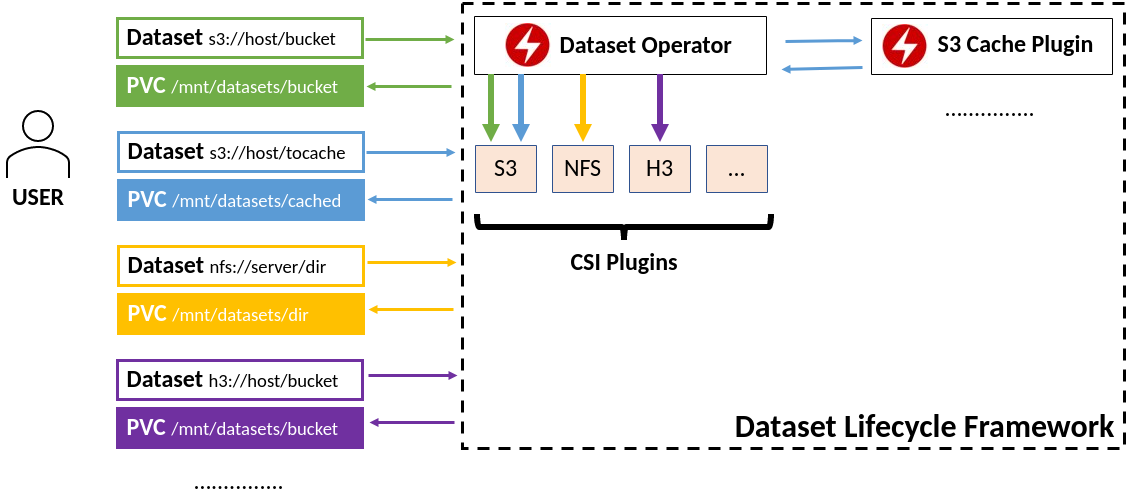Our Framework introduces the Dataset CRD which is a pointer to existing S3 and NFS data sources. It includes the necessary logic to map these Datasets into Persistent Volume Claims and ConfigMaps which users can reference in their pods, letting them focus on the workload development and not on configuring/mounting/tuning the data access. Thanks to Container Storage Interface it is extensible to support additional data sources in the future.
A Kubernetes Framework to provide easy access to S3 and NFS Datasets within pods. Orchestrates the provisioning of Persistent Volume Claims and ConfigMaps needed for each Dataset. Find more details in our FAQ
In order to quickly deploy DLF, based on your environment execute one of the following commands:
- Kubernetes/Minikube
kubectl apply -f https://raw.githubusercontent.com/IBM/dataset-lifecycle-framework/master/release-tools/manifests/dlf.yaml- Kubernetes on IBM Cloud
kubectl apply -f https://raw.githubusercontent.com/IBM/dataset-lifecycle-framework/master/release-tools/manifests/dlf-ibm-k8s.yaml- Openshift
kubectl apply -f https://raw.githubusercontent.com/IBM/dataset-lifecycle-framework/master/release-tools/manifests/dlf-oc.yaml- Openshift on IBM Cloud
kubectl apply -f https://raw.githubusercontent.com/IBM/dataset-lifecycle-framework/master/release-tools/manifests/dlf-ibm-oc.yamlWait for all the pods to be ready :)
kubectl wait --for=condition=ready pods -l app.kubernetes.io/name=dlf -n dlfAs an optional step, label the namespace(or namespaces) you want in order have the pods labelling functionality (see below).
kubectl label namespace default monitor-pods-datasets=enabledIn case don't have an existing S3 Bucket follow our wiki to deploy an Object Store and populate it with data.
We will create now a Dataset named example-dataset pointing to your S3 bucket.
cat <<EOF | kubectl apply -f -
apiVersion: com.ie.ibm.hpsys/v1alpha1
kind: Dataset
metadata:
name: example-dataset
spec:
local:
type: "COS"
accessKeyID: "{AWS_ACCESS_KEY_ID}"
secretAccessKey: "{AWS_SECRET_ACCESS_KEY}"
endpoint: "{S3_SERVICE_URL}"
bucket: "{BUCKET_NAME}"
readonly: "true" #OPTIONAL, default is false
region: "" #OPTIONAL
EOFIf everything worked okay, you should see a PVC and a ConfigMap named example-dataset which you can mount in your pods.
As an easier way to use the Dataset in your pod, you can instead label the pod as follows:
apiVersion: v1
kind: Pod
metadata:
name: nginx
labels:
dataset.0.id: "example-dataset"
dataset.0.useas: "mount"
spec:
containers:
- name: nginx
image: nginxAs a convention the Dataset will be mounted in /mnt/datasets/example-dataset. If instead you wish to pass the connection
details as environment variables, change the useas line to dataset.0.useas: "configmap"
Feel free to explore our examples
Have a look on our wiki for Frequently Asked Questions
Have a look on our wiki for Roadmap
Reach out to us via email:
- Yiannis Gkoufas, yiannisg@ie.ibm.com
- Christian Pinto, christian.pinto@ibm.com
- Srikumar Venugopal, srikumarv@ie.ibm.com
- Panagiotis Koutsovasilis, koutsovasilis.panagiotis1@ibm.com
This project has received funding from the European Union’s Horizon 2020 research and innovation programme under grant agreement No 825061.

